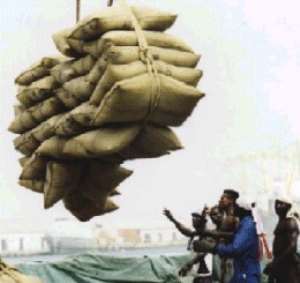
Accra, May 30, GNA - Cocoa production is expected to drop from last year's 735,000 tonnes to about 600,000 tonnes this year with an attendant squeeze earnings, the Governor of the Central Bank, Dr Paul Acquah said on Monday.
The Governor, said cocoa revenue might not be the same as was achieved in Ghana's record production last year.
Speaking to Journalists at a press conference after this month's Meeting of the Monetary Policy Committee (MPC), Dr Acquah said purchases at the end of the 18th week were fixed at a low of 470,000 tonnes, noting that, "last year, this figure was achieved at the end of the 14th week, indicating that this could lead to a slow down in money supply generally."
The Governor dismissed claims that the record production last year was due to the smuggling of cocoa beans from Ghana's Western corridor, Cote d'Ivoire, which is the world's largest producer, arguing that evidence proved that a large proportion of beans was actually purchased in areas far from the borders.
He attributed the decrease to a number of factors including the fact that the harvesting cycle and the extent to which cocoa trees were prolific in fruit bearing had changed resulting in late flowering and thus late bearing of fruits.
Dr Acquah noted that the fundamentals of the economy were "solid and strong" saying that the BoG Business Confidence Survey indicated that while there was some softening in business confidence in the first quarter, "businesses remain generally optimistic about their own prospects and those of the economy this year".
He said the Central Bank's Composite Index of Economic Activity rose by 26.0 points (13.4 per cent) over the March 2004 level. "This indicates a sustained increase in the level of economic activity in the first quarter of 2005. This is reflected in port activity, industrial electricity consumption, tourist arrivals and the additional number of employees for which the private sector makes contributions to SSNIT."
He said credit to the private sector as a percentage of GDP increased from 10.3 per cent in March 2004 to 11.2 per cent by March 2005.
Dr Acquah described the distribution of increased credit to the private sector as broad-based, "but more significant in manufacturing, personal and mortgage loans, commerce and finance." Agriculture, forestry and fishing, however, recorded marginal declines.
Dr Acquah said the banking system as a whole continued to remain well capitalized, profitable, fairly liquid and sound with a more improved loan portfolio.
On the external front, provisional estimates of the current account of the balance of payments showed a deficit of 123.9 million dollars, an improvement from a deficit of 288.7 million recorded over the previous quarter compared to a surplus of 35.4 million dollars in the first quarter of last year.
Quarterly export earnings increased by 5.5 per cent ending at 701.5 million dollars, compared with 664.5 million dollars in the preceding quarter.
"Cocoa beans and products accounted for 214.6 million dollars, slightly exceeding contributions from other exports, including non-traditional exports, which amounted to 208.6 million dollars compared to the 121.6 million in the first quarter of 2004," he said. A large trade deficit of 336.8 million dollars on the trade account had offset the surplus of 212.9 million dollars on services, income and transfers account.




 We’ll protect state wealth from opaque deals – Prof Jane Naana
We’ll protect state wealth from opaque deals – Prof Jane Naana
 Mauritania president says running for second term in June polls
Mauritania president says running for second term in June polls
 I won't ever say I was a mere driver’s mate' — Prof. Opoku-Agyemang
I won't ever say I was a mere driver’s mate' — Prof. Opoku-Agyemang
 2024 polls: 'EC struggling to defend credibility'— Prof. Opoku-Agyemang
2024 polls: 'EC struggling to defend credibility'— Prof. Opoku-Agyemang
 Akufo-Addo gov't's 'greed, unbridled arrogance, unrestrained impunity, sheer dis...
Akufo-Addo gov't's 'greed, unbridled arrogance, unrestrained impunity, sheer dis...
 Election 2024: Ghana needs an urgent reset, a leadership that is inspiring – Ma...
Election 2024: Ghana needs an urgent reset, a leadership that is inspiring – Ma...
 Partner NDC to rollout a future of limitless prospects – Prof Jane Naana Opoku-A...
Partner NDC to rollout a future of limitless prospects – Prof Jane Naana Opoku-A...
 NPP will remain in gov’t till Jesus comes — Diana Asamoah
NPP will remain in gov’t till Jesus comes — Diana Asamoah
 Sunyani Technical University demands apology from former SRC president over sex-...
Sunyani Technical University demands apology from former SRC president over sex-...
 'Dumsor' was resolved by Mahama but ‘incompetent' Akufo-Addo has destroyed the g...
'Dumsor' was resolved by Mahama but ‘incompetent' Akufo-Addo has destroyed the g...
